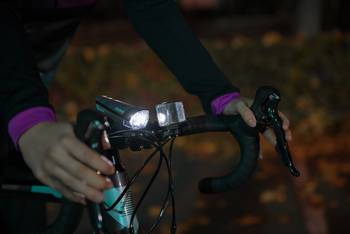No matter what kind of cyclist you are, it's worth knowing what else bike lights can give you
other than the
ability to see or be seen. In this article, we'll delve into lumens, waterproof ratings, and
more.
What are lumens?
Lumens (sometimes written as lm) are a way of measuring a
light's output;
in other words: how bright it is. Rear lights are usually between 5 and 100
lumens, whereas
a front light can be anything from 10 up to thousands of lumens.
For comparison, the full moon on a clear night is about 1 lumen, a smartphone's backlight is
around 20, and a
single standard car headlight is 1200 lumens.
Many lights' advertised maximum lumen output is in flashing mode, so if you're going to be using
a constant
mode, bear in mind that it may put out slightly less light than advertised. Where possible,
we'll show max
lumens for all modes on a product's page.
You may also hear about lux. Lux takes into account the surface area in which
the light is
spread. Several light brands have used lux previously as it's an accurate measurement for
determining what
we actually see in front of us. Whilst lumen is the most common measurement of light output, it
doesn't
always equal the light quality in a real world setting.
If you're riding on unlit roads, you're probably going to want a front light that's around
600
lumens as a minimum, but you also want to make sure that you're not going to be
dazzling any
oncomers. When cycling on the road, it's important to get a light that's not going to blind any
oncoming
traffic. To avoid this, look for a light with a narrow beam pattern.
Some lights will state that they are best suited for off-road cycling, and those will be the ones
that you
want to avoid using on the road. That said, many of these lights will allow you to turn their
brightness
down, so there's no need to compromise if you're going to be riding both on and off-road. If you
are going
to be riding off-road at night, look for lights rated above 1,000 lumens.
It's worth knowing that light performance can drop as the battery runs out, so it's always worth
having a few
low-cost spare lights on you, or buying a light with a battery life that's longer than your
average ride
time.
If your battery is running low, switch to a flashing or eco mode where possible. Don't risk using
a flashing
mode on unlit roads, but in built-up areas it's ideal and can help to make you even more
visible.
Mounts and brackets
No matter where you're riding, the strength of your light's mount is pretty important. Some
mounts can slip
if you're riding over bumps, and attempting to adjust them whilst riding isn't easy (and nor do
we recommend
it!). Because of this, we'll always try to give an indication of how secure the mount is.
Many rear lights are secured to your bike with a simple silicone strap, making them easy to
attach and
remove. Safety lights will also be secured this way.
Many front lights also feature straps, but you'll also come across clamp mounts. These are a lot
more rugged
and are able to withstand bumpy trails with ease. They'll usually require tools to assemble so
they aren't
as quick to secure to your bike as a strap mount, but will often feature a quick release for
easy removal.
It's worth considering a light with a silicone strap mount if you're going to be swapping your
light between
bikes.
Waterproof rating
Riding in the UK and Ireland means you're definitely going to need a set of bike lights with a
decent
waterproof rating. Waterproof ratings on lights vary, so it's worth knowing what those letters
and numbers
mean.
Waterproof ratings begin with 'IP', which stands for Ingress Protection. It will then be followed
by two
numbers - the first number is the protection from solid particles (dust), whereas the second
number is the
protection from liquid.
We don't recommend buying a light that's less than IP64. A light rated at IP63
will allow
water spray in at a certain angle, whereas a light rated at IP64 is protected against spray from
any
direction. As you continue up the scale, the waterproof protection is even greater: IP67 can
withstand
immersion up to 1 metre, which should be more than enough for any cyclists' needs!
Shop all Lights
Back to
Expert Advice

